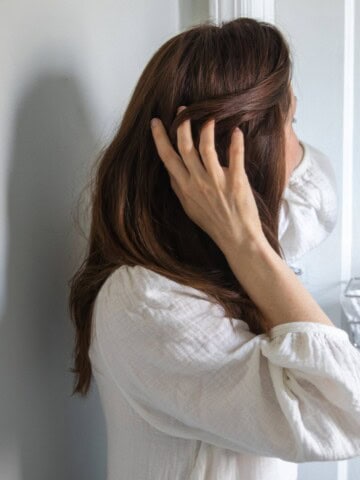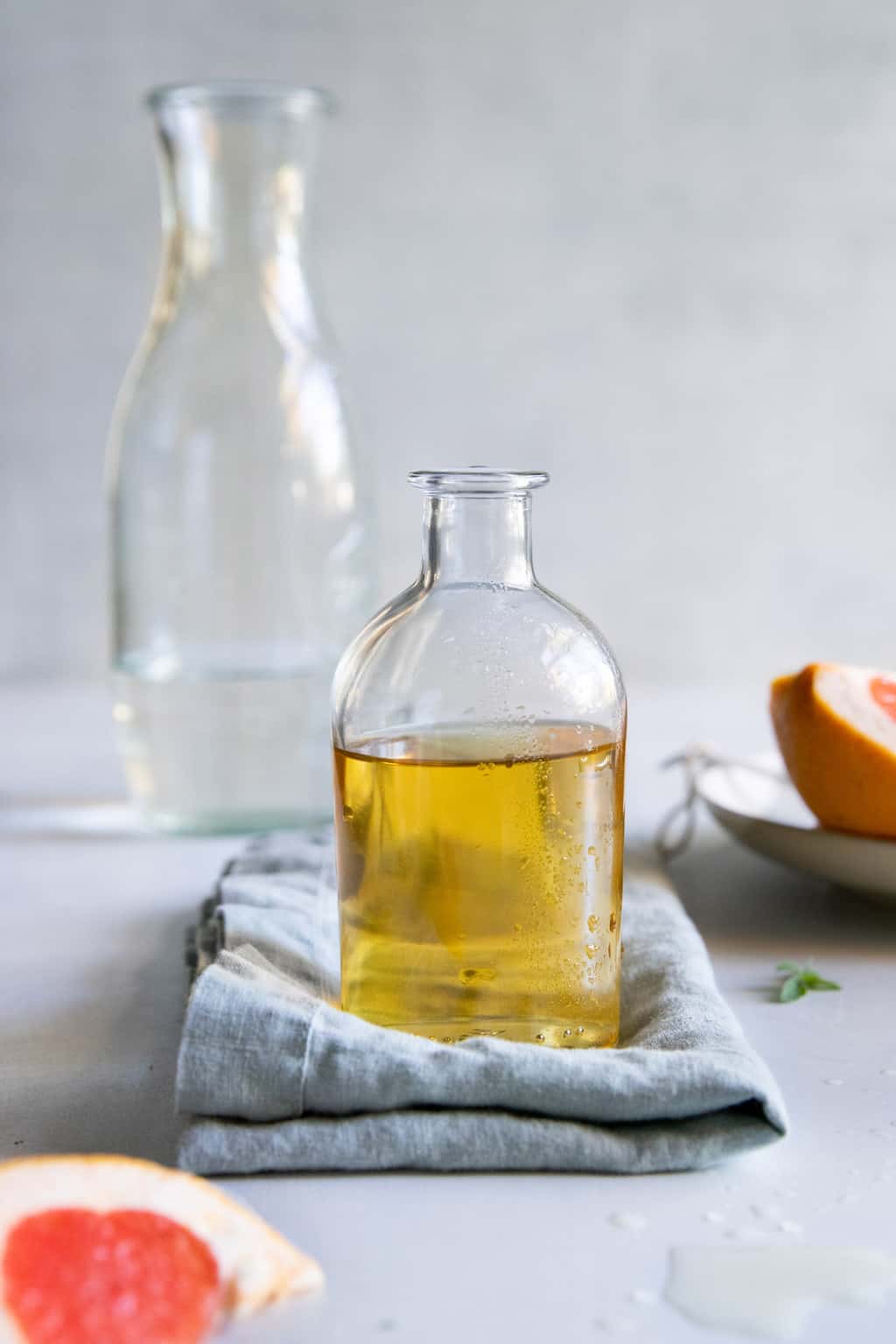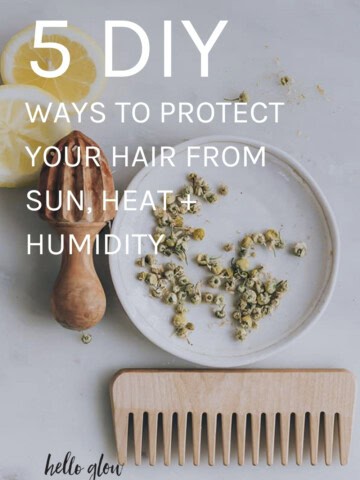Making my own apple cider vinegar hair rinse has quickly become my go-to secret for lackluster hair. Not only does it get rid of the gunk that used to weigh down my hair, but it also makes my locks soft and super shiny. Here’s how to make your own version of this hair fixer-upper.
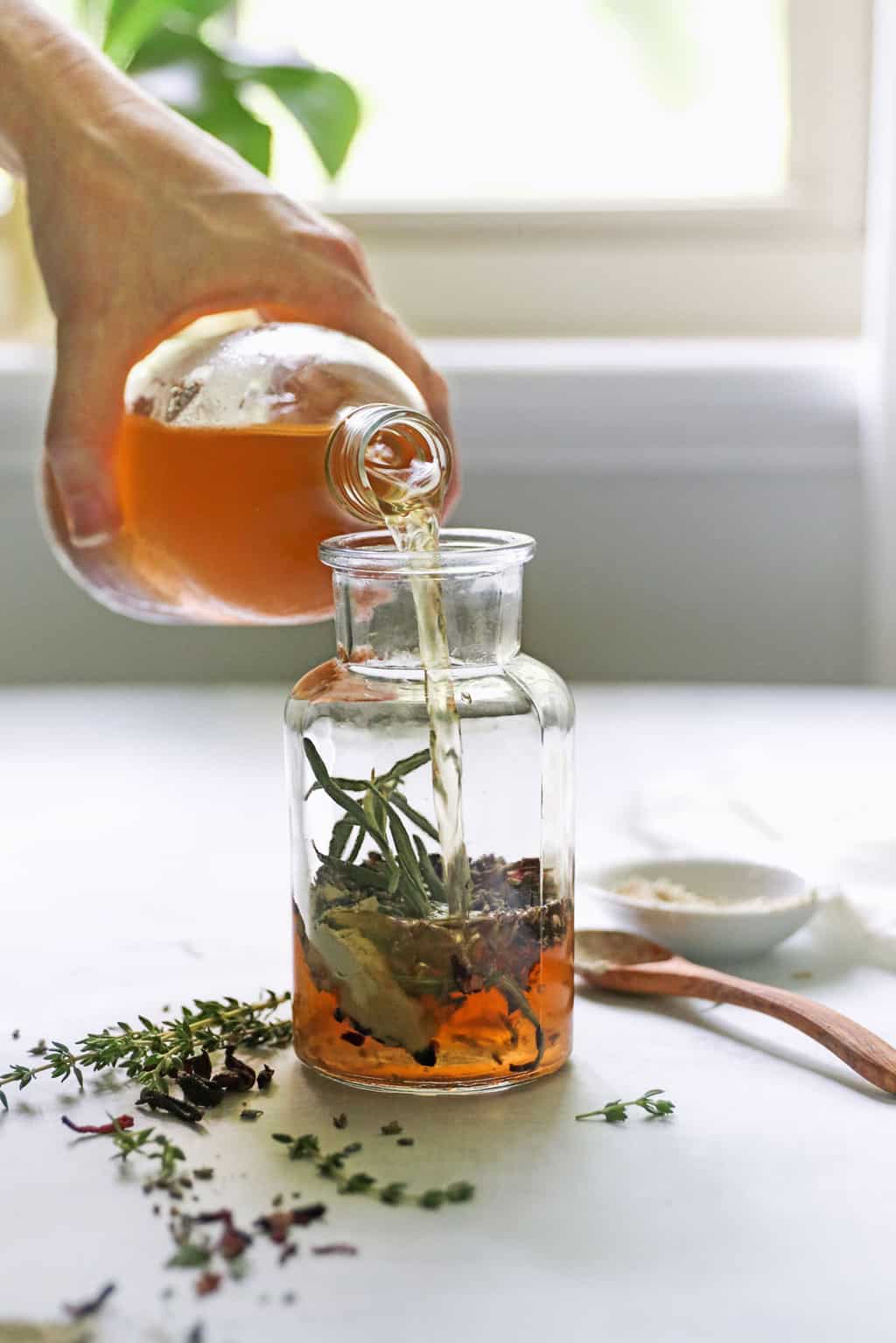
One of the bloggers I follow on Instagram is always talking about her obsession with apple cider vinegar, which is just fermented apple juice. She swears up and down that it helps with clearing up acne to balancing her blood sugar, which published research actually supports [source], and just about everything in between. I decided to give it a try—you know, just to see.
One surprising benefit I didn’t see coming? My hair has never looked better!
Plus, by infusing my hair rinse with hair-boosting herbs, I’ve noticed more growth, less flakiness, and fewer bad hair days to boot.
Jump to:
- Apple Cider Vinegar Hair Benefits
- Ingredients
- Instructions
- Diluting an Apple Cider Vinegar Rinse
- Applying a Vinegar Hair Rinse
- Storage
- Can I Use Fresh Herbs?
- ACV Rinse Recipes for Every Hair Type
- 1. Vinegar Rinse for Dry Hair
- 2. Vinegar Rinse for Oily Hair
- 3. Vinegar Rinse for Dandruff
- 4. Vinegar Rinse for Volume
- 5. Vinegar Rinse for Shiny Hair
- 6. Vinegar Rinse for Hair Growth
- 7. Vinegar Rinse for Colored Hair
- References
Meet the Experts
- Andrew Fitzsimons, celebrity hairstylist
- Gina Rivera, celebrity stylist and founder of Phenix Salon Suites
- Bridgette Hill, trichologist and owner of Bridgette Hill Scalp Therapy
- Dr. Jennifer Haley, a board-certified dermatologist, who medically reviewed this post
Apple Cider Vinegar Hair Benefits
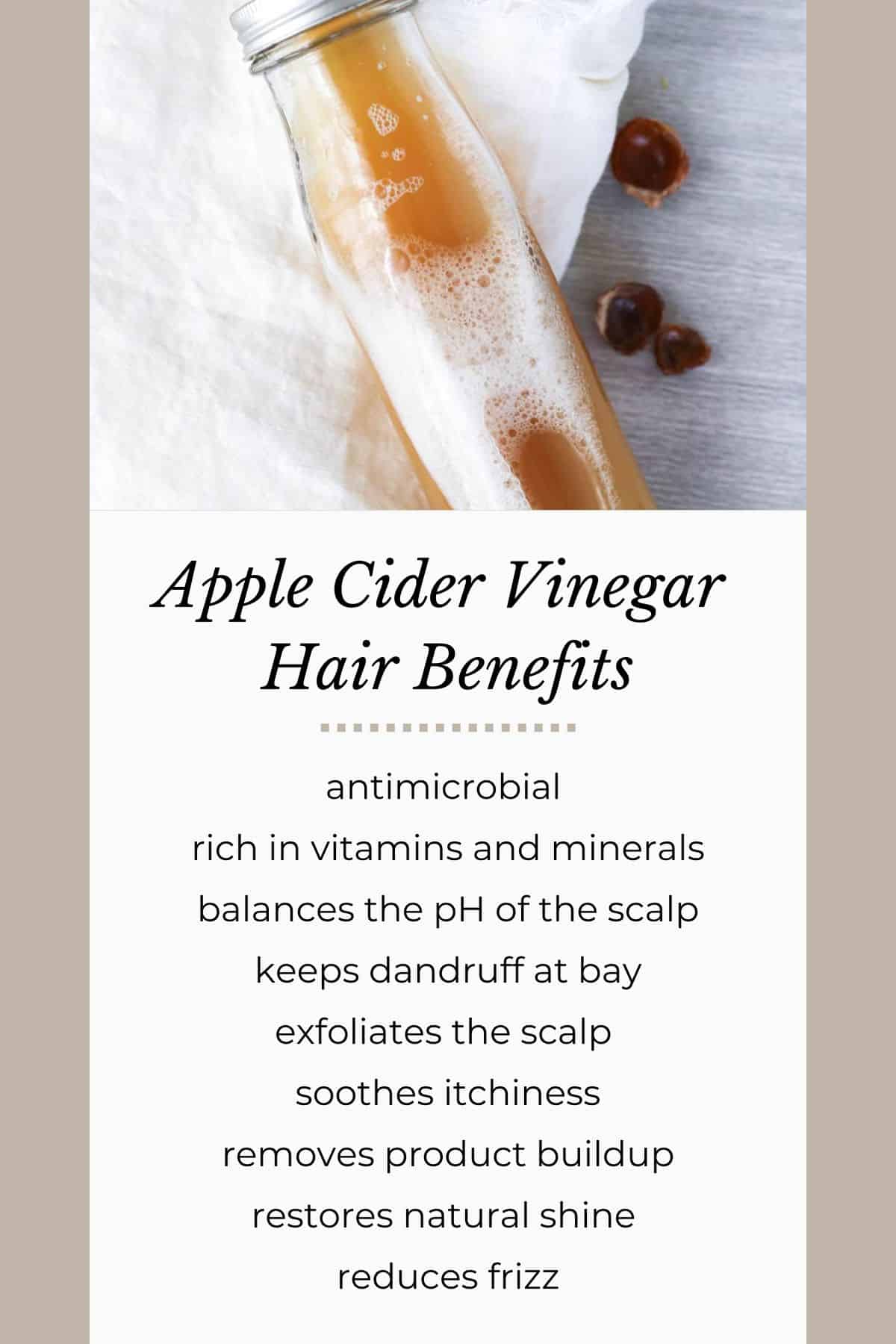
Hairstylists have been using this kitchen staple to enhance the appearance of their clients’ hair for years. Even Andrew Fitzsimons, a celebrity hairstylist whose client list includes JLO, Meghan Fox, and Kim Kardashian, gives ACV a thumbs up.
“Apple cider vinegar will add a shine to your tresses by coating the cuticle, which will make hair softer and stronger and even help prevent breakage,” he says. “ACV is also great for balancing your scalp’s pH level—thanks to its antibacterial properties.”
But the benefits don't stop there!
1. Restores pH Balance
ACV has a pH level that is similar to human hair, typically around 4.5 to 5.5, which helps restore the hair’s natural pH balance. Maintaining this balance is crucial for the scalp's health and keeps the cuticle layer flat, reducing frizz for smooth, shiny hair.
By replenishing healthy bacteria and re-balancing your scalp’s pH, you may even see less dandruff and oil production than usual. Hallelujah.
2. Antimicrobial Properties
ACV possesses natural antimicrobial properties, which can help reduce levels of bacteria and fungus associated with dandruff and other scalp conditions. Regular use can lead to a healthier scalp, potentially reducing itchiness and dandruff.
3. Detangling
Apple cider vinegar can help smooth the hair's surface, allowing easier brushing and detangling. When used as a post-shampoo rinse the acid in ACV helps to close the hair's cuticle, which not only decreases tangles but also enhances shine and reduces frizz.
4. Cleansing and Clarifying
Apply ACV to your roots with a rinse or a shampoo, and you'll soon notice less buildup, oils, and other residues that weigh down the hair over time. Its natural acidity helps clarify over-styled locks and unclog hair follicles, leaving hair cleaner and with more volume.
5. Enhances Hair Shine
The smoothing of the hair’s cuticle from the acidic nature of ACV results in hair that reflects light better, thus appearing shinier. This is one of the most sought-after benefits of apple cider vinegar rinses.
6. Promotes Hair Health and Growth
While direct evidence linking ACV to accelerated hair growth is limited, its role in maintaining a healthy scalp environment can support the conditions favorable for hair growth. By keeping the scalp clean and improving blood circulation, ACV can indirectly aid in healthier hair growth.
7. Reduces Frizz
By smoothing down the cuticles on the hair shaft, ACV helps to reduce frizz and increase manageability. This effect can make the hair appear sleeker and less prone to static and tangling.
And that’s how this herb-infused apple cider vinegar hair rinse was born.
Ingredients
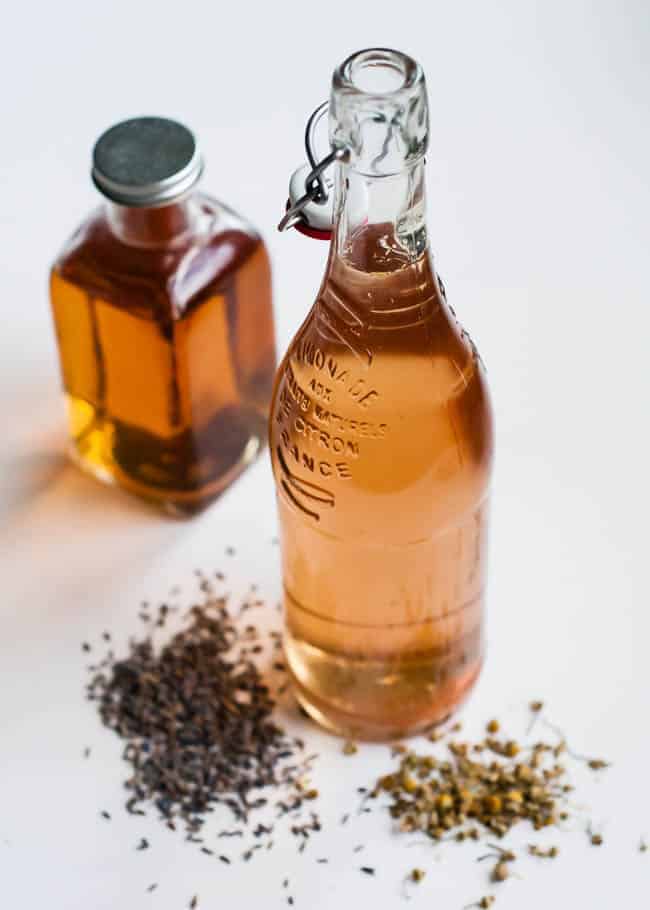
Apple cider vinegar
If you want to reap the benefits of ACV, it’s best to choose an organic raw vinegar that contains “the mother.”
This means it’s unfiltered, unrefined, and still contains the beneficial bacteria, yeast, and proteins that are so good for the scalp’s microbiome. My personal favorite is Bragg Organic Apple Cider Vinegar, but I have seen other brands out there that look comparable.
Herbs for Hair
Herbs make your apple cider vinegar hair rinse that much more potent. For mine, I used rosemary, hibiscus, lavender, and marshmallow root. Dried herbs are easier to use. Since they don’t contain any moisture so there's less chance of mold growing while the herbs infuse.
- Hibiscus: Because they are packed with vitamins, minerals, organic acids, and antioxidants [source], dried hibiscus flowers can help improve the overall health of your hair and scalp. I would avoid this if you have blonde or light brown hair because it gives the ACV a red tint, which is great for red or dark hair highlights but could temporarily stain lighter hair (where I would suggest trying chamomile instead).
- Lavender: Lavender is an anti-inflammatory herb [source] that has been shown to promote hair growth in animal studies [source]. It has also been said to deep condition hair, helping to keep it soft and shiny.
- Rosemary: Rosemary is loaded with antioxidant polyphenols, oils, and nutrients that nourish the root, encourage hair growth [source], and increase circulation in the scalp. If you don’t have access to fresh or dried herbs, add a couple of drops of rosemary essential oil for the same hair growth benefits.
- Marshmallow root: Marshmallow root contains low concentrations of ceramide precursors that bind to the hair, making strands look thicker and feel stronger. It contains mucilage, like a protective film [source] that is somewhat slippery and can be used as an alternative to conditioner.
Instructions
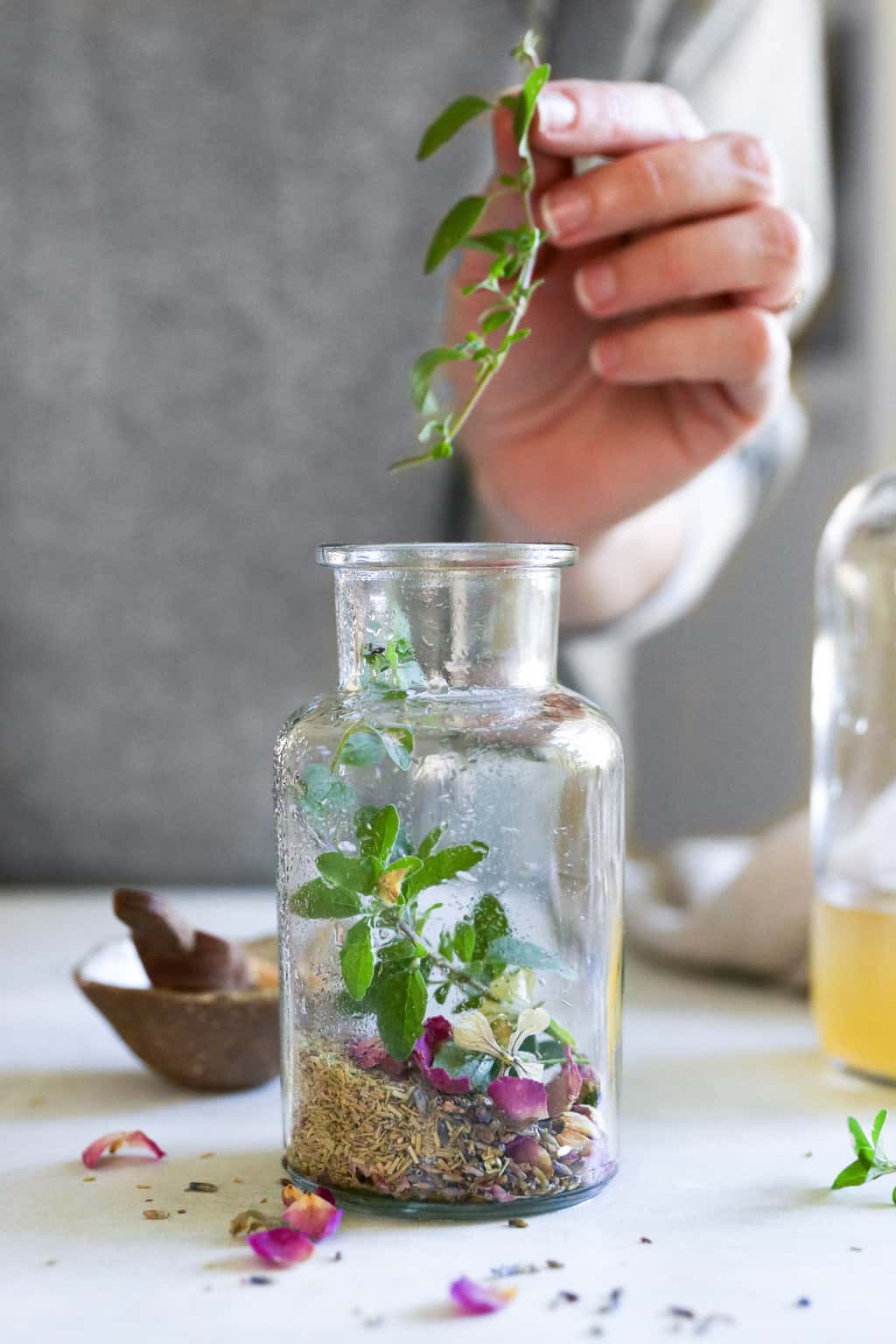
Step 1: Prepare Herbs
Choose dried herbs that are suited to your hair's needs. If you're using fresh herbs, ensure they're clean and chopped.
Use about ¼ cup of dried herbs or ½ cup of fresh herbs for each cup of apple cider vinegar. Place the herbs in a clean glass jar. Gently muddle the herb mixture with a wooden spoon to help release some of the botanical properties.
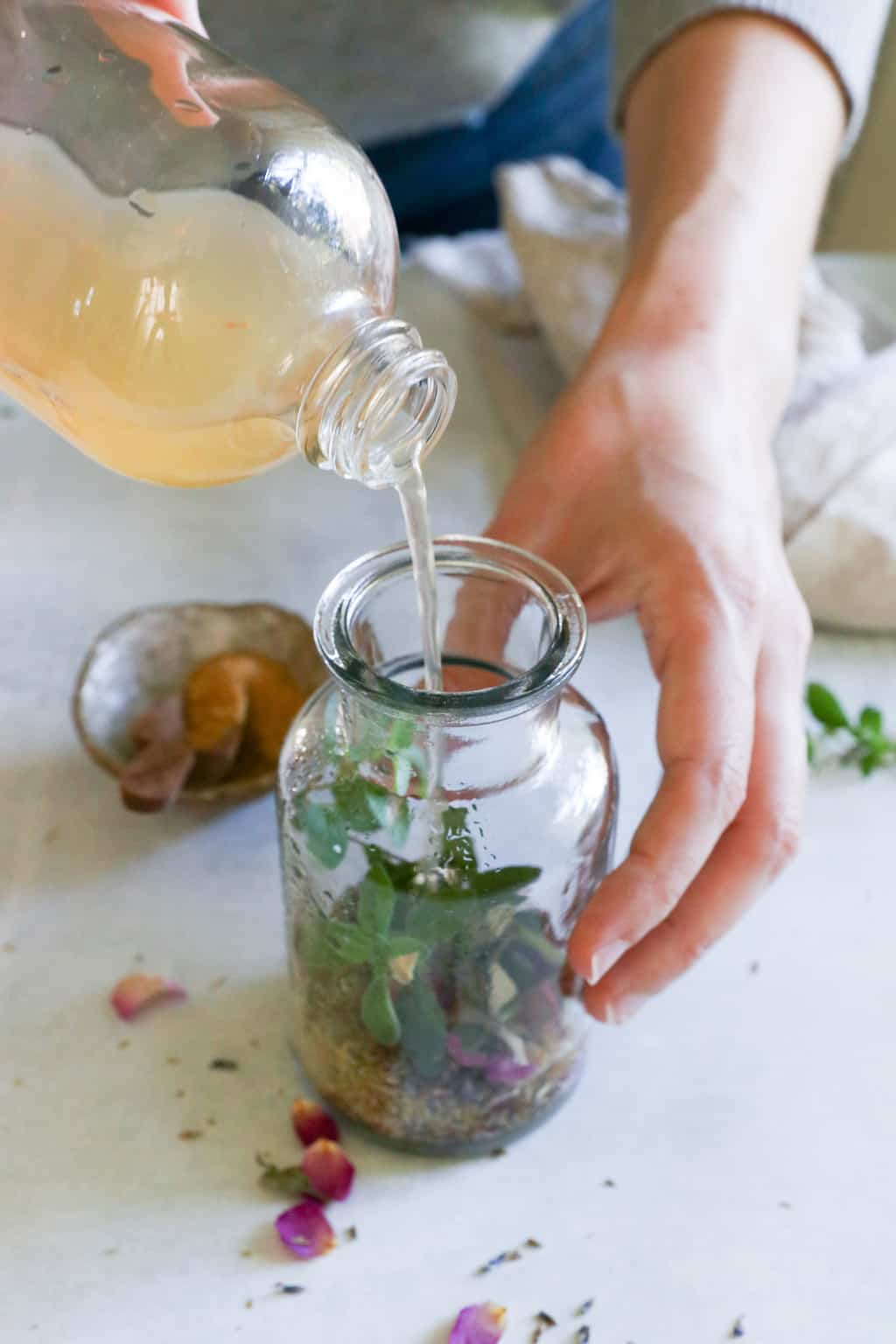
Step 2: Infuse Vinegar
Pour apple cider vinegar over the herbs until they are fully submerged. Keep a little breathing room between the vinegar and the upper edge of the jar, where the lid rests.
Then, seal the jar tightly and sit it in a cool, dark place for about 2-4 weeks. Shake the jar every few days to mix the herbs.
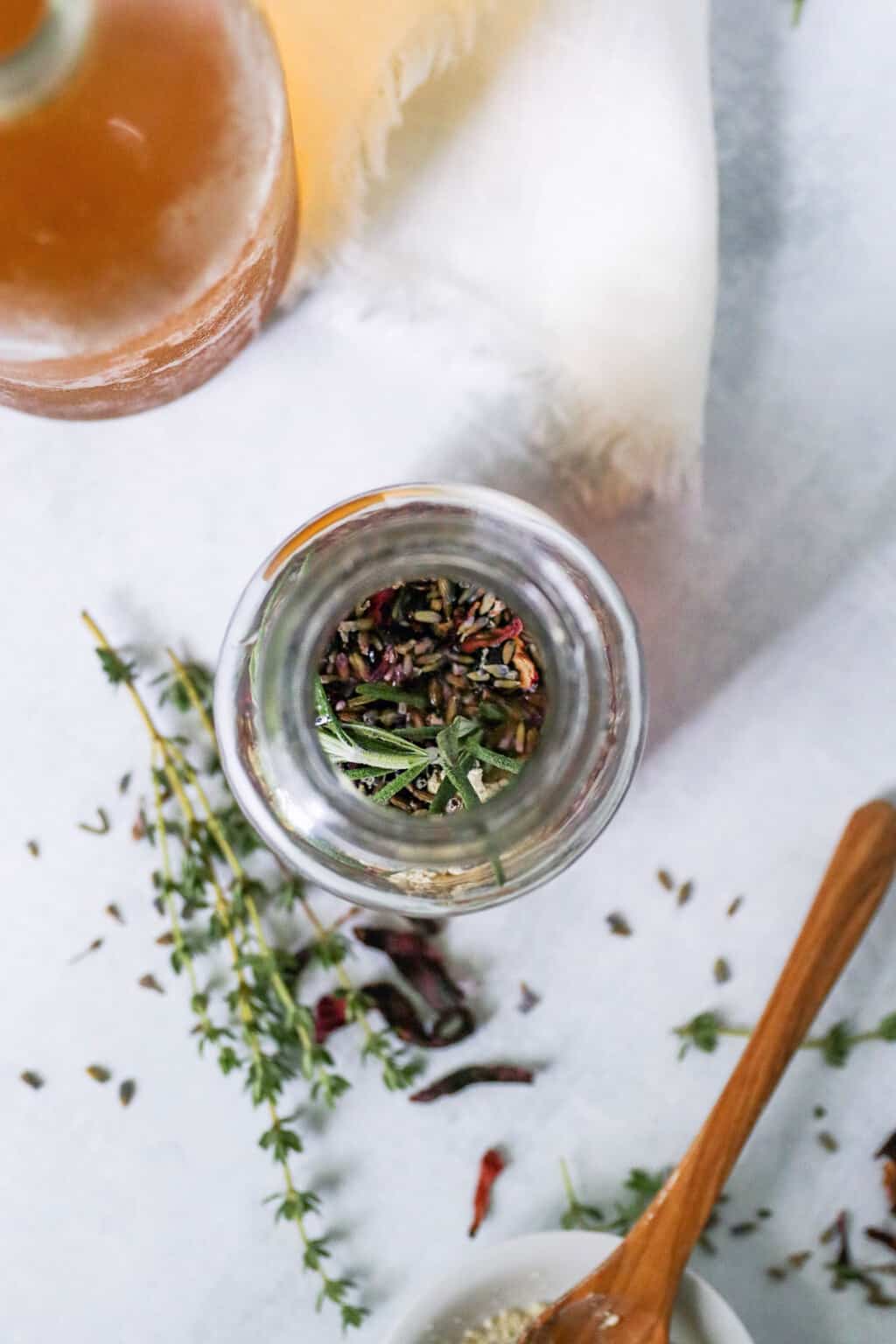
Step 3: Strain Herbs
After the infusion period, strain the vinegar (cheesecloth is better at removing finely ground herbs, but a fine-mesh strainer will also work) into another clean jar or bottle. Compost or discard the herbs.

Step 4: Dilute
To use, dilute the infused vinegar with water. A typical ratio is 1 part vinegar to 3 parts water, but you can adjust based on your scalp sensitivity and hair type.
Store the undiluted infused vinegar in a cool, dark place.
Diluting an Apple Cider Vinegar Rinse
When using apple cider vinegar, Gina Rivera, celebrity stylist and founder of Phenix Salon Suites, recommends always diluting it first by adding water, as undiluted ACV can be far too acidic for the hair.
“As with everything, always use this treatment in moderation to avoid stripping the hair and damaging it,” she says. “Depending on the amount of products a person uses, this treatment should be done no more than once per week or bi-weekly.”
Rivera recommends one part vinegar to 5 parts water, but 1 part vinegar and 3 parts water is also common.
“The rinse can be customized to be stronger or weaker, depending on the water to ACV ratio used when mixing, allowing those with scalp concerns versus those with no obvious scalp conditions," explains Bridgette Hill, trichologist and owner of Bridgette Hill Scalp Therapy.
In addition to water, you can dilute the ACV with other liquids like these:
Applying a Vinegar Hair Rinse
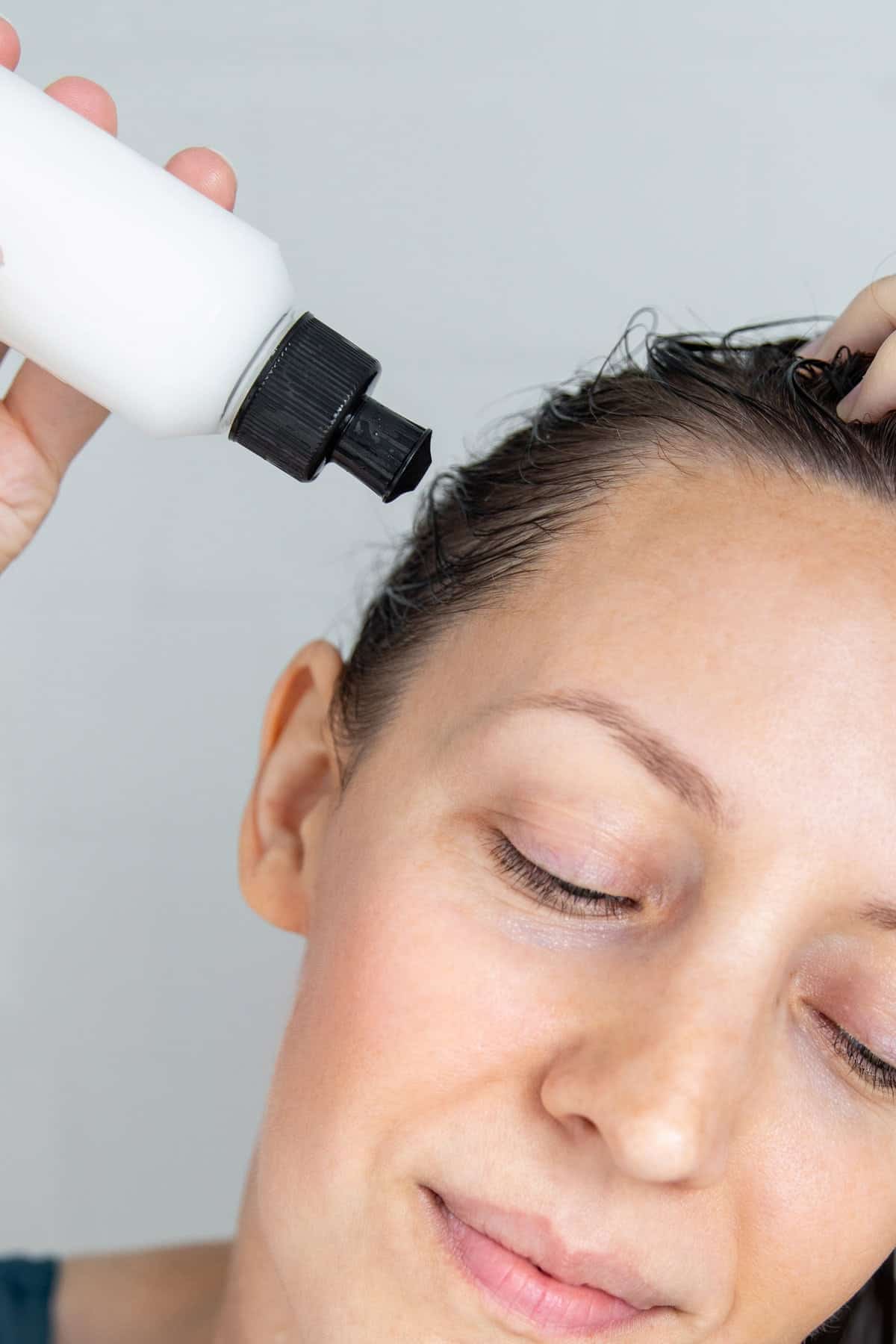
Pour + Comb Through: Pour the amount of ACV you want to use in a small squirt bottle or other container then add water to dilute it. Apply it to clean wet hair (try this ACV shampoo!). Massage it into the scalp and comb through the lengths of your hair.
Rinse Out or Leave-In: You can choose to rinse it out with cool water after a few minutes or leave it in to dry naturally.
Don't like the smell? Add a few drops of essential oils like lavender or rosemary to the diluted rinse for added benefits and a more pleasant scent.
Storage
The herb-infused vinegar should keep indefinitely without requiring refrigeration. However, water encourages bacterial growth, so don’t dilute the mixture until you’re ready to use it.
If you accidentally get water in the rinse mixture, use it up within a week.
Can I Use Fresh Herbs?
Fresh is fine, but you'll need to use more plant material. Just make sure they’re completely submerged in the vinegar and that no part of the plant is exposed to air.
If the herb comes in contact with air, it will start to mold before it’s had a chance to infuse the vinegar. If you notice mold at any point during the infusion process, toss out the mixture and start again.
ACV Rinse Recipes for Every Hair Type

1. Vinegar Rinse for Dry Hair
Herbs for dry hair:
- Burdock Root, Comfrey, Marshmallow Root: These herbs are rich in mucilage, which is a gelatinous substance that helps moisturize and condition the hair, making it ideal for dry and brittle hair.
- Elderflowers, Lavender: They have soothing properties that calm the scalp and reduce dryness and irritation.
- Parsley, Sage: These herbs are known for their nutrient content, including vitamins and minerals that nourish the hair.
- Stinging Nettle: Nettle leaves are rich in phytochemicals, amino acids, silica, and sulfur [source], which are great hair boosters.
Instructions
Combine ¼ cup of herbs in a jar and cover with 1-2 cups of ACV. Infuse for 2 weeks then strain the mixture and dilute 1 part infused vinegar with 3 parts water before use.
2. Vinegar Rinse for Oily Hair
Herbs for oily hair:
- Calendula, Lemon Balm, Mint, Yarrow: These contain natural astringents that help tighten the scalp’s pores and reduce excess sebum production.
- Horsetail, Rosemary: These stimulate the scalp, improving circulation and thereby helping to regulate oil production.
- Witch Hazel: It has cleansing effects that help remove excess oil without stripping the scalp of necessary moisture.
- Lemon Juice: Acts as a clarifier and grease cutter, helping to remove oil buildup.
Instructions
Combine ¼ cup of herbs in a jar and cover with 1-2 cups of ACV. Infuse for 2 weeks then strain the mixture. Before using, dilute 1 part infused vinegar with 3 parts water and add the juice of one lemon.
3. Vinegar Rinse for Dandruff
Herbs to combat dandruff:
- Nettle: Applying nettle topically not only promotes hair growth, but its healthy amount of antioxidants and anti-inflammatory compounds [source] can also help scalp conditions like psoriasis and dandruff.
- Burdock Root: Both are excellent for scalp health, promoting blood circulation and being rich in essential nutrients that support hair health.
- Garlic, Onion: These contain sulfur and have antimicrobial properties that are effective against the fungi and bacteria that can cause dandruff and flaky scalp.
- Parsley, Thyme, Rosemary: Thyme delivers powerful nutrients to hair follicles that are necessary for healthy hair growth. Like parsley and rosemary, thyme may help improve blood circulation to the scalp, fight bacteria [source], and encourage hair to grow thicker and stronger.
Instructions
Combine ¼ cup of herbs in a jar and cover with 1-2 cups of ACV. Infuse for 2 weeks then strain the mixture and dilute 1 part infused vinegar with 3 parts water before use.
4. Vinegar Rinse for Volume
Herbs for body and luster:
- Calendula, Catnip, Nasturtium, Rosemary, Sage: These herbs improve hair's overall texture and shine, with natural compounds that smooth hair cuticles, enhancing light reflection.
- Horsetail, Licorice, Lime Flowers, Watercress: Rich in silica and other minerals that strengthen hair, add body, and prevent brittleness.
- Parsley: Provides nutrients that feed the hair roots and enhance health and sheen.
Instructions
Combine ¼ cup of herbs in a jar and cover with 1-2 cups of ACV. Infuse for 2 weeks then strain the mixture and dilute 1 part infused vinegar with 3 parts water before use.
5. Vinegar Rinse for Shiny Hair
Herbs for shine:
- Horsetail, Nettle: Both are rich in silica, which strengthens hair and enhances shine by smoothing the hair cuticles.
- Parsley, Rosemary, Sage: These provide essential nutrients and antioxidants, improving hair health and its natural sheen.
- Calendula: Adds to the luster and conditions the scalp.
Instructions
Combine ¼ cup of herbs in a jar and cover with 1-2 cups of ACV. Infuse for 2 weeks then strain the mixture and dilute 1 part infused vinegar with 3 parts water before use.
6. Vinegar Rinse for Hair Growth
Herbs for hair growth:
- Aloe, Arnica, Chamomile, Marigold: Soothing and anti-inflammatory, these help maintain a healthy scalp environment conducive to hair growth.
- Birch, Burdock, Nettles, Rosemary, Sage, Stinging Nettle: Stimulate blood flow to the scalp, which is vital for nourishing hair follicles and promoting hair growth.
- Catmint, Horsetail, Licorice, Parsley: These contain various nutrients and minerals that support hair strength and prevent hair loss.
- Ginseng: Ginseng is often found in shampoos and conditioners because of its hair-stimulating benefits. Not only does it promote hair growth, but it may also reduce shedding and inflammation in the scalp [source].
Instructions
Combine ¼ cup of herbs in a jar and cover with 1-2 cups of ACV. Infuse for 2 weeks then strain the mixture and dilute 1 part infused vinegar with 3 parts water before use.
7. Vinegar Rinse for Colored Hair
Herbs for coloring hair:
- Henna, Walnut Hulls, Sage (Brown Hair): These provide natural dyes, with henna offering a rich reddish-brown color, while walnut hulls and sage deepen the shade.
- Calendula, Chamomile, Lemon, Saffron, Turmeric, Rhubarb Root (Blonde Hair): These ingredients have natural lightening properties that can subtly enhance blonde tones through prolonged use.
Instructions
Combine ¼ cup of herbs in a jar and cover with 1-2 cups of ACV. Infuse for 2 weeks then strain the mixture and dilute 1 part infused vinegar with 3 parts water before use.
Herb-Infused Apple Cider Vinegar Hair Rinse
Equipment
- 64-ounce glass jar with lid
- Cheese cloth or fine mesh strainer
Materials
- ¼ cup rosemary (dried is preferred)
- ¼ cup lavender (dried is preferred)
- 2 tablespoons hibiscus flowers (dried is preferred)
- 2 tablespoons ground marshmallow root
- 3 cups organic, unfiltered, raw apple cider vinegar
Instructions
- Combine all herbs in a glass jar. Stir with a spoon to mix everything together.
- Pour the vinegar over the herbs, then screw the lid on tightly and shake well.
- Place the jar in a cool, dark location. Shake it every couple of days and top off with additional apple cider vinegar as needed to keep the level the same. After about 2 weeks, strain the herbs from the vinegar using cheesecloth or a strainer.
Notes
References
References
Johnston CS, et al. Vinegar: medicinal uses and antiglycemic effect. MedGenMed. 2006.
Izquierdo-Vega JA, et al. Organic acids from Roselle (Hibiscus sabdariffa L.)—a brief review of its pharmacological effects. Biomedicines. 2020.
Cardia GFE, et al. Effect of lavender (Lavandula angustifolia) essential oil on acute inflammatory response. Evid Based Complement Alternat Med. 2018.
Lee BH, et al. Hair growth-promoting effects of lavender oil in C57BL/6 mice. Toxicol Res. 2016.
Panahi Y, et al. Rosemary oil vs minoxidil 2% for the treatment of androgenetic alopecia: a randomized comparative trial. Skinmed. 2015.
Rezzoug M, et al. Chemical composition and bioactivity of essential oils and Ethanolic extracts of Ocimum basilicum L. and Thymus algeriensis Boiss. & Reut. from the Algerian Saharan Atlas. BMC Complement Altern Med. 2019.
Choi BY. Hair-growth potential of ginseng and its major metabolites: a review on its molecular mechanisms. Int J Mol Sci. 2018.
Kregiel D, et al. Urtica spp.: ordinary plants with extraordinary properties. Molecules. 2018.
Pekmezci E, et al. Proprietary herbal extract downregulates the gene expression of IL-1α in HaCat cells: possible implications against nonscarring alopecia. Med Arch. 2018.
Bonaterra GA, et al. Anti-inflammatory and anti-oxidative effects of Phytohustil® and root extract of Althaea officinalis L. on macrophages in vitro. Front Pharmacol. 2020.
This post was medically reviewed by Dr. Jennifer Haley, a board-certified dermatologist with extensive experience in medical, cosmetic, and surgical dermatology. Learn more about Hello Glow’s medical reviewers here. As always, this is not personal medical advice, and we recommend that you talk with your doctor.
264


